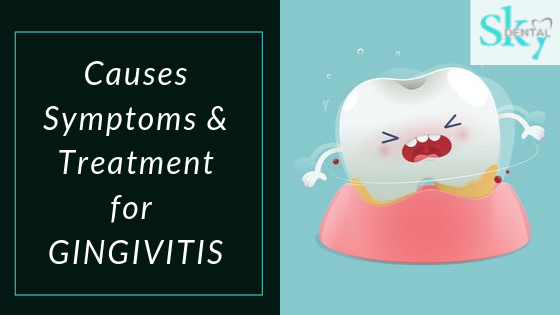Gingivitis is a common inflammation of the gums. It commonly occurs because of the build-up of plaque, a naturally occurring sticky thing like bacteria accumulates on the teeth. This plaque produces toxins that irritate gums. As a result, this further causes irritation, redness, and swelling of your Gingiva (the part of your gum at the roots of your teeth).
If it is left without treating, gingivitis can expand further and also leads to gum disease called Periodontitis. This is most common in adults with the major cause of tooth loss. Beyond gingivitis, this harmful bacteria can even lead to issues like weakened tooth enamel. Gingivitis is often painless, so if you exhibit any signs or symptoms its important to take it seriously and visit your dental professional.
One of the most common causes of gingivitis is poor oral hygiene. Brushing and flossing twice a day and getting regular dental checkups can help prevent gingivitis.
Types of Gingivitis
Gingivitis can be classified into two main categories
Dental plaque-induced gingival disease – Plaque, systemic factors, and medications are the causes of this type of Gingival disease.
Non-plaque induced gingival lesions – Specific bacterium and virus are the main causes. It can often cause by genetic factors, systemic conditions (like allergic reactions and certain illnesses), wounds and dentures.
What are the main causes of Gingivitis?
The main cause of Gingivitis is the build-up of bacterial plaque on the teeth and gums. As a result, this may further irritate the gums and cause them to bleed. Dental plaque accumulates naturally on the teeth. When this plaque is not removed it can harden into calculus at the base of teeth and gums. This has a yellow colour and it can only be removed professionally.
How Plaque can lead to Gingivitis?
Plaque formation on your teeth – Plaque is an invisible, sticky film that built up from the bacteria on your teeth. This occurs when starches and sugars in food interact with bacteria. The plaque should be removed daily because it can reform quickly.
Plaque turns into tartar – Plaque on your teeth can harden under your gumline into calculus (tartar), which collects bacteria. Tartar creates a protective shield for plaque that makes it more difficult to remove. As a result, it further causes irritation to the gumline.
Gingiva becomes inflamed – As long the plaque remains on your teeth, as more the gingiva irritates. This leads to inflammation. Also, your gums become swollen and bleed easily. As a result, tooth decay occurs. If it is left without treating gingivitis can advance to periodontitis and also tooth loss.
There are some of the other factors might increase the risk of gingivitis. If some of the below-mentioned factors apply to you, pay extra attention to your teeth and gum line.
Tobacco use
Smoking is one of the greatest factors that lead to Gum disease and there are fewer chances for successful treatment. According to research smokers are seven-time more likely to suffer from gingivitis than people who do not smoke!
Not maintaining good hygiene
Not brushing or flossing regularly is one of the several causes for gingivitis. Avoiding regular dental check-ups from your dentist may also lead to severe problems like this.
Untreated Plaque
Leaving plaque untreated may lead you to severe problems like Gingivitis. Be sure to floss regularly and use a toothpaste that can reach the plaque around the gumline.
Hormonal Changes
Hormonal changes like puberty, pregnancy, menopause, and menstruation can cause increased sensitivity and inflammation in your gums. Intensive Care is mandatory for the gums during these physiological changes to prevent gum disease.
Stress
Stress is also one of the causes of Gingivitis. Constant stress can weaken your immune system and decreases your ability to fight infection including gum disease.
Poor Nutrition & Chronic diseases
Lack of nutrition deprives the body of important nutrients. Also, Chronic diseases like diabetes, cancer, and HIV reduce your ability to fight infection.
Signs and Symptoms
As Gingivitis does not cause much pain, many people don’t know that they have it! This is why visiting a dental hospital for regular check-ups and cleanings.
- Bright red and puffy gums.
- Painful and bleeding gums when you brush or floss.
- Bad breath and dry mouth.
- Tooth pain or sensitivity when exposed to hot or cold foods.
- Inflammation or swollen gums.
- Poor oral habits and poor nutrition.
- Smoking or chewing tobacco.
Treatment and Prevention
Treating and preventing gingivitis is all about removing the plaque from teeth and gums. The best way to treat it is by making a dental appointment as soon as possible. Your dentist will remove plaque using special tools.
Some of the tips to prevent gingivitis are
- Brush at least for two minutes twice a day – morning and before going to bed. Floss whenever you eat something. Brushing and flossing allow you to remove the bacterial plaque from the teeth.
- Use an anti-plaque toothpaste containing fluoride with the guidance of your dentist. As a result, it strengthens your teeth and prevents the damage caused by bacteria as it build-ups on teeth.
- Don’t forget to visit the dental hospital regularly for a checkup.
This article is intended to promote understanding of and knowledge about general oral health topics. It is not intended to be a substitute for professional advice, diagnosis or treatment. Always seek the advice of your dentist at a dental hospital in Vijayawada qualified healthcare provider with any questions you may have regarding a medical condition or treatment


